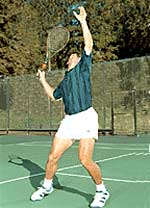|
TennisOne QuickTips
QuickTip: What "Punctuation Mark" is Your Overhead? Dave Smith
The overhead is one of the most curious tennis strokes. The reason I say this is that, for some, the overhead is anticipated with almost salivary glee. For others, attempting the overhead is fraught with dread and trepidation. And for still others, hitting an overhead is simply not an option; these players opt to take any high ball and either let it bounce and run it down, or let it drop in order to volley the ball instead. Certainly, a player's strategy can almost eliminate the need for an overhead; namely, players who simply refuse to come to the net. When forced to move towards the net, these players, following a shot near the net, retreat, scurrying back to the baseline as fast as possible. It sometimes appears to onlookers as if the net were radioactive or some sinister monster to these players!
More than any other shot in tennis, the quality of a player's overhead can be evaluated through the analogy of grammatical punctuation. For example, does your overhead typically finish the point with an exclamation point? Or, does a question mark better describe your overhead? Is there always a "comma" at the end of your overhead, (signifying the probability that your opponents will get it back!), or do you avoid overheads and prolong the rally like a run-on sentence? (A rally that should have been over several shots earlier!)
When a player is looking to improve their overhead, (and ultimately finish points with an exclamation point!) there are two main issues that must be addressed. They are Technique and Reaction Preparation. Technique There are a many lessons on technique found in the TennisONE Lesson Library. I highly recommend all players review the wonderful tips found there. In a nutshell, proper technique includes a sideways body position, continental grip, elbow pointed back on the backswing, off hand pointing towards the ball, (Figure 1) and similar movements we see in the serve; namely, pronation of the forearm and racquet from an 'edge on' position (of the racquet prior to contact) to a 'high five' analogy at contact. Generally, the finish of an overhead includes the hitting elbow remaining above the racquet head as the racquet continues down and across the body. (Figure 2) Reaction Preparation The problem many players have, even while they posses proper or skilled overhead technique, is the initial reaction to the lob the moment it is hit. Commonly, players look up and evaluate the lob in determining if they can or should hit an overhead. By the time the player has made any evaluation, the lob will usually be too far behind them to be hit well, if at all.
Challenge the Overhead Make a habit of 'challenging' every lob. The moment the lob is hit, immediately turn sideways making your 'unit turn' and shuffling back quickly in an attempt to get under the ball. If, in fact, the lob is too good, you have lost nothing. In doubles, your partner, if playing smart doubles, will be going back to cover the lob until they see that you have control of it. In singles, if you can't hit the overhead out of the air, since you have already started going back as if to hit the overhead, you will usually have plenty of time to turn and run it down after it bounces and hit a defensive lob yourself, or hit a quality groundstroke if you can get in position. (Or, if you want to live dangerously, hit a 'tweener'!) So, while you are working on developing a quality overhead, work on the proper reaction to the lob...and challenge the overhead! (Click link to purchase Dave Smith's book, Tennis Mastery, at tenniswarehouse.com |


